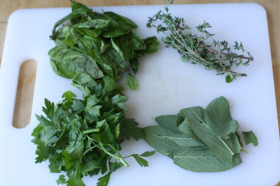Trail Report: Trails were rolled (but not tracked) on Tuesday. Some places thin and icy, but it is white!
The thankful people of Crossroads sang the song of “harvest home” several months ago when students helped us safely gather in vegetables and herbs and from our Heritage Garden (and donated to Feed My People) ere the winter storms began. Crossroads will be closed from Wednesday until Saturday afternoon in order to celebrate Thanksgiving with friends and family, but our trails will be open.
To most, the celebration on Thanksgiving involves turkey and dressing flavored with poultry seasoning. Poultry seasoning is a combination of herbs, among which are parsley, sage, rosemary and thyme. (Humm….that sound so familiar, and not just because we grow them in our garden.)
When I list “sage,” I suppose most Americans would think of sagebrush—the pungent plant of the West. Actually, sagebrush is a member of the sunflower family while, like rosemary and thyme, true sage is in the mint family.
Mints have long been cherished as flavorings. The first century naturalist Pliny the Elder wrote, “The smell of mint stirs up the mind and appetite to a greedy desire for food.” Modern researchers have some evidence that mental stimulation and alertness might indeed be increased by the scent of peppermint.
Appetite stimulation? Yep. What worked in ancient Rome still works at Thanksgiving, but why? It turns out that plants in the mint family have glands which exude volatile oils. When they evaporate into the air, these mint oils give off scents which attract insect pollinators to the plants. Mint oils…sage, rosemary and thyme… when added to food, give off an aroma which makes the food more palatable to us.
But, as it turns out, the original reason for adding sage and other herbs to rich foods was far more mundane. Since the Middle Ages, sage has been valued for its medicinal properties. Herbalist believed it cured everything from fever to soft gums and heartache. According to these early physicians, sage was especially helpful in “preventing bilelessness and flatulence.” When rich food was served, especially in close quarters, sage was added as a preventative measure.
Consequently, the flavors have become associated with chicken and turkey. The combination of the herbs of poultry seasoning have been passed down through the generations. If they prevent flatulence, I guess we have one more thing for which to be thankful.
If you are thankful for intelligent discussion and stimulating ideas, you might enjoy the December Meeting of the Door Peninsula Astronomical Society. Actually, the search for intelligent life is the topic, as Professor Ray Stonecipher presents the lecture “SETI.” He will describe the Search for Extraterrestrial Intelligence by means of an exploratory science that seeks evidence of life in the universe by finding some signature of technology. Coggin Heeringa will offer the “This Month in Astronomy.” Refreshment will be served. Please use the Utah Street Entrance to reach the Astronomy Campus
We are thankful for Friends of Crossroads, the group of people dedicated to promoting the programs of Crossroads at Big Creek—and decorating the Collins Learning Center. Besides “decking the halls” the Friends have a tradition of sharing holiday treats, warm cider, and fellowship and they invite non-members to join in the fun. A short meeting will follow the festivities.
Crossroads is a donor-supported preserve welcoming learners of all ages to programs in science, history and the environment. The


